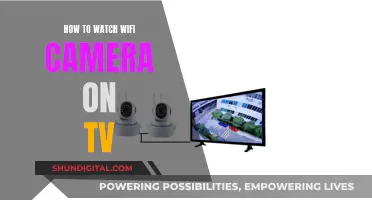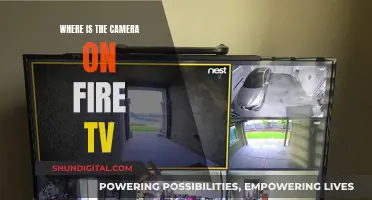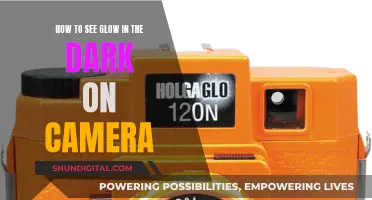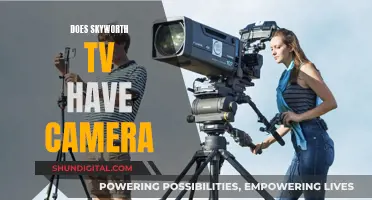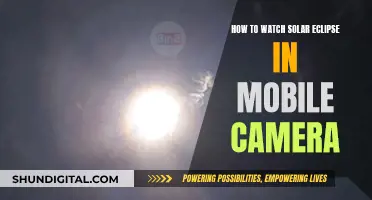
Running with a camera can be a great way to capture beautiful scenery and memorable moments during your workout. However, it's important to consider the type of camera and how to carry it comfortably and safely. Some people opt for lightweight and compact cameras, such as smartphones, GoPro, or point-and-shoot cameras, which can be easily carried in an armband, pocket, or small backpack. For those using DSLR or mirrorless cameras, a well-padded camera backpack with chest and waist straps is recommended to distribute the weight and minimise bouncing. It's also crucial to wrap the camera in a protective case or clothing to prevent damage from jostling during the run.
| Characteristics | Values |
|---|---|
| Running with a camera | Annoying, clunky, heavy, risky |
| Running with a phone | Unwieldy, poor image and audio quality |
| Running with a GoPro | Steady image quality, usable audio |
What You'll Learn

Running with a DSLR camera
- Choose the right bag: Opt for a snug-fitting backpack designed for running, as regular camera bags are not built for this purpose and can bounce around, throwing off your form. Look for running vests or slim running backpacks with chest and waist straps for added stability. Some recommended brands include Salomon, Lihynmy, Osprey, and Tamrac. If you want to carry your camera in your hand, consider a wrist strap for added security.
- Protect your camera: Use a padded insert or divider in your bag to protect your camera from impact and prevent it from moving around too much. You can buy pre-made inserts or create your own DIY solution with foam or a towel. If you're running in wet conditions, consider a waterproof bag or a rain cover for your backpack.
- Consider the weight: The weight of your gear will affect your running form and comfort. Mirrorless cameras are a good option for running as they are smaller and lighter than DSLRs. If you do take a DSLR, consider leaving some of your heavier lenses at home and packing only what you need.
- Be mindful of movement: While running with a DSLR is generally safe, constant, intense vibration or impact can potentially damage your gear over time. Be especially careful with heavy lenses as they can stress the lens mount. If you're running on challenging terrain, consider securing your camera in your bag or backpack during the trickiest sections of your run.
- Practice and prepare: If you're new to running with a camera, start with shorter distances and work your way up. Practice different carrying methods to find what works best for you. Remember to pack spare batteries, memory cards, and other essentials.
- Know your priorities: Running with a DSLR can be cumbersome and may distract you from your run. If you're training for a race or aiming for a personal record, you may want to leave the camera at home. Alternatively, you can opt for a more lightweight option like a smartphone, GoPro, or compact camera.
Understanding the TV Setting on Your Camera
You may want to see also

Running with a phone camera
Phone Camera Setup
- Consider investing in a smartphone with a good camera. Modern iPhone and Android phones have excellent cameras that can rival dedicated cameras.
- Install apps that allow you to have more control over your phone's camera settings, such as shutter speed and exposure.
- Protect your phone with a case or cover to safeguard it from any potential damage while running.
Running Gear
- Use a running belt, armband, or small backpack to carry your phone securely and comfortably.
- If you plan to bring other running essentials, like water or snacks, opt for a running backpack with compartments to keep your phone protected.
- Consider a waterproof or sweatproof bag or case to keep your phone dry during your run.
Photography Techniques
- Look for interesting subjects or scenic spots along your running route. Take advantage of parks, city landmarks, and natural lighting to capture unique photos.
- Experiment with different types of shots, such as wide vistas, close-ups of interesting details, or action shots of other runners or animals.
- Try to keep your phone stable while taking photos. Hold it with both hands, or use a small tripod or gimbal for sharper images.
- Be mindful of your surroundings and other runners. Step to the side or stop running momentarily when taking photos to avoid collisions.
- Utilize photo editing apps to enhance your images, adjust exposure, or apply creative filters.
- Running with a phone camera can help you appreciate your surroundings and discover new places in your area.
- It encourages you to look up and explore, rather than keeping your head down and focusing only on your run.
- Combining running and photography can make your runs more enjoyable and provide a creative outlet.
- You can capture unexpected moments, interesting subjects, or beautiful scenery that you might otherwise miss.
Accessing Your Computer Camera's View: A Step-by-Step Guide
You may want to see also

Running with a GoPro camera
Choosing the Right GoPro Model:
The GoPro Hero 7 Black and GoPro Hero 9 Black and GoPro Max 360 are excellent choices for running. The Hero 9 offers the steadiest image quality and usable audio among the GoPro options. It also boasts the highest resolution at 5K, ensuring crisp and detailed footage. The Max 360, on the other hand, provides a unique 360-degree perspective and the signature bright, clean GoPro style. It allows you to capture everything around you simultaneously, ensuring you don't miss any action.
Mounting and Carrying Options:
There are several ways to carry your GoPro while running, each offering different perspectives:
- Chest Mount: This option captures what your chest is pointed at and is ideal if you want a stable shot of your running form or the path ahead. However, some users find that chest mounts can flop around.
- Head Mount: A head mount, such as a headband, can provide a unique perspective, but some runners may find it uncomfortable to wear for extended periods.
- Handheld: Holding the GoPro in your hand or attaching it to a short selfie stick gives you more control over the framing and allows you to point the camera in any direction. This method is recommended if you want to capture specific shots or include yourself in the frame.
- Backpack Mount: You can attach your GoPro to a backpack strap, providing a unique angle and keeping your hands free. However, this method may result in bouncy or unstable footage.
- Running Vest: A running vest with pockets can securely hold your GoPro, especially those with front and side pockets for easy access. Some vests are designed to absorb sweat, keeping your camera dry.
Audio Considerations:
While the GoPro captures audio, running in windy conditions can result in low wind rumble in the audio track. If clear audio is important to you, consider using WindBoost mode on the GoPro Max or similar audio enhancement features on other models.
Post-Processing:
GoPro cameras make it easy to edit and enhance your footage. The GoPro Quik app, for example, is great for editing clips and creating shareable content. Additionally, with 360-degree footage, you can reframe and edit your video to focus on specific parts of the action, ensuring you don't miss any memorable moments.
Remember to review your footage, edit it to your liking, and share your running adventures with the world!
Accessing Street Camera Footage: A Step-by-Step Guide
You may want to see also

Running with a 360-degree camera
Choosing the Right Camera
Select a 360-degree camera that suits your needs and budget. Some popular options include the Insta360 X4, GoPro Max, and Insta360 One RS. These cameras offer features such as high-resolution video capture, waterproofing, and stabilisation. Consider the video quality, ease of use, rugged design, and mounting options when making your choice.
Carrying the Camera
Decide how you will carry the camera while running. Some options include a chest pouch, a lightweight backpack, or a belt bag. Ensure that the camera is well-padded and doesn't bounce around too much while you run, as this could affect the quality of your footage and cause discomfort.
Stabilisation
Look for a camera with good stabilisation features, such as optical or electronic image stabilisation, to counteract the vibrations and movements from running. This will help ensure that your footage is smooth and stable.
Mounting Options
Consider the mounting options available for your camera. Many 360-degree cameras come with standard GoPro-style mounts or have built-in mounts. You can attach these cameras to a helmet, surfboard, chest mount, or selfie stick to capture different perspectives.
Battery Life
Keep in mind that most action cameras have limited battery life, typically lasting about an hour at maximum resolution and frame rate. If you plan on running for extended periods, consider bringing extra batteries or a portable charger.
Editing Software
Familiarise yourself with the editing software or app provided by the camera manufacturer. These tools will allow you to edit, trim, and reframe your 360-degree footage, as well as add special effects and transitions.
Creative Opportunities
Take advantage of the unique capabilities of 360-degree cameras. You can capture everything around you, allowing for creative panning, zooming, and cropping in post-production. Experiment with different angles and perspectives to create dynamic and immersive videos.
Apple Watch Camera: Where is it?
You may want to see also

Running with a gimbal camera
Choosing the Right Gimbal
When selecting a gimbal for running, consider factors such as battery life, features, and price. Some gimbals offer longer battery lives than others, which can be crucial if you plan to be out for an extended period. Additionally, look for gimbals with stabilization modes like lock mode, pan following mode, selfie mode, and panoramic mode. These modes will help you capture a wide range of shots and ensure smooth and stable footage.
Camera and Gimbal Protection
When running with a gimbal camera, it is essential to protect your equipment from damage. Use a snug backpack or a chest pouch with soft padding to secure your gimbal camera. This will prevent the camera from bouncing around and reduce the risk of impact with other objects in your backpack. Consider using a plastic bag or a towel to wrap around your camera for added protection.
Comfort and Stability
Opt for a gimbal with an ergonomic design that is comfortable to hold and provides stability. A gimbal with a chest strap or waist strap can help distribute the weight more evenly and reduce strain on your arms and back. Additionally, look for gimbals with adjustable straps to ensure a secure fit.
Weight Considerations
Keep in mind that the weight of the gimbal and camera setup will affect your running tempo. A heavier setup will make your run more challenging, so consider the weight of the gimbal and camera before purchasing. Remember that you will also need to account for the weight of any additional accessories, such as external microphones or lights.
Running Technique
When running with a gimbal camera, be mindful of your form and technique. Try to minimize up and down movement and avoid bouncing, as this can affect the stability of your footage and increase the risk of equipment damage. Consider running at a slower pace or adjusting your stride to reduce the impact on your body and equipment.
Additional Accessories
There are several accessories that can enhance your experience when running with a gimbal camera. Consider using a peak design capture camera clip to attach your gimbal to your backpack or belt. Additionally, an extension rod can provide more reach and versatility in your shots. You may also want to invest in spare batteries, as gimbal batteries tend to have limited lives.
Mobile Camera Tricks: See-Through Clothes
You may want to see also
Frequently asked questions
Running with a DSLR can be uncomfortable and clunky. The bag carrying the camera is likely to bounce and shift, which can be annoying. It's also important to have a bag with chest and waist straps to stabilize the weight.
Some alternatives to a DSLR include high-end point-and-shoot cameras, such as the Canon G7X Mk II, Sony RX100 Mk V, or Panasonic DMC-ZS100. Smartphones, especially newer models like the iPhone 8 or X, can also take high-quality photos and are a more convenient option.
There are a few options for carrying a camera while running. Some people suggest using a snug backpack with padding to protect the camera. Others recommend a chest or waist strap to stabilize the camera and reduce bouncing.
Yes, there are camera bags designed specifically for running or other outdoor activities. For example, the LowePro PhotoSport AW 200 II is a running-friendly camera bag that can carry a DSLR and lenses.
Combining photography and running requires striking a balance between the two activities. Consider the weight and stability of your camera gear, and choose a comfortable way to carry it. Plan your route to include photogenic locations, and consider the lighting and timing of your run to capture the best scenes.


